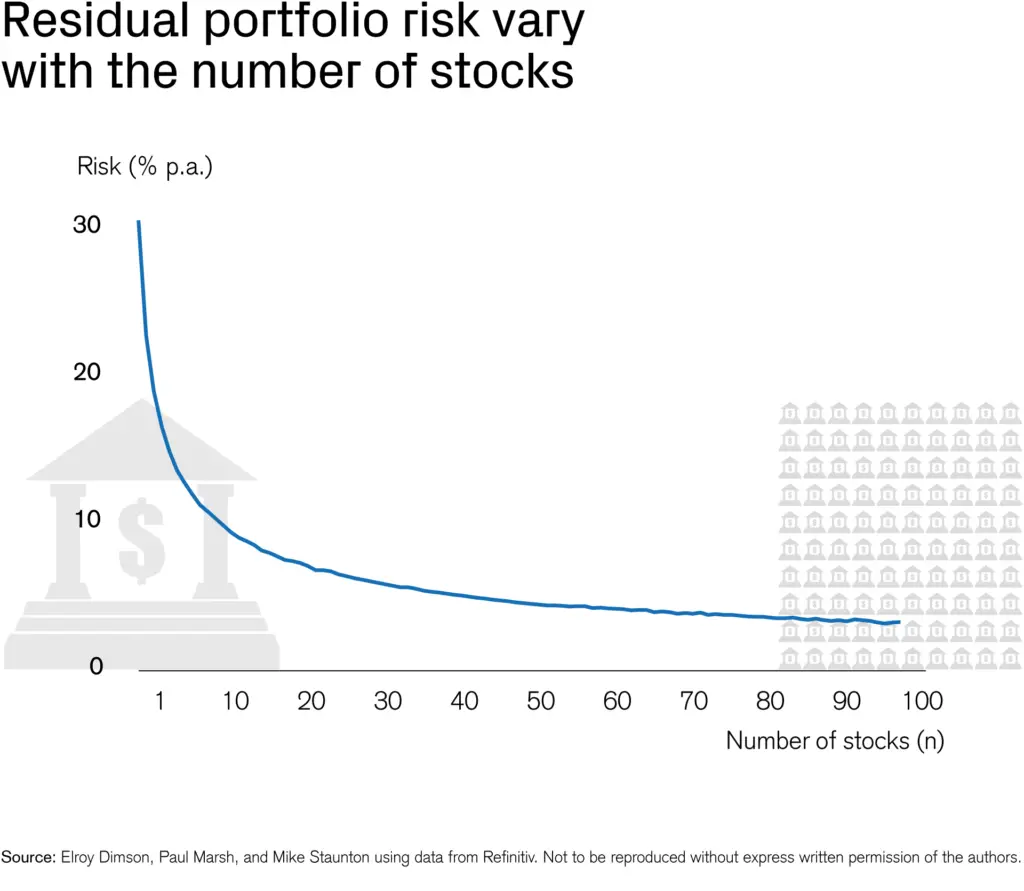Diversification is often touted as the only free lunch in investing, and most investors feel they have to diversify their portfolios in order to reduce risk. But is that completely true? What exactly are the advantages and disadvantages of portfolio diversification?
In this comparison article, we will go over each and every advantage and disadvantage of a diversified portfolio.
How to diversify your portfolio

Diversifying your portfolio may seem like a very simple concept, all you have to do is to buy other assets or stocks, and your portfolio is now diversified and protected from risk and volatility - but that is not always the case.
One of the key components of building a diversified portfolio is choosing assets that are uncorrelated because if you diversify into related assets your will be increasing your risk exposure instead of reducing it.
Let’s consider an example, let’s say you have invested in Ford (NYSE: F), you may think that buying Tesla (Nasdaq: TSLA) would diversify your portfolio right? Well in reality you are simply exposing your portfolio to additional risks that may come from a slowdown in the economy or an event that could affect automakers, especially those who rely on the US and North American markets.
To avoid making these mistakes you need to consider diversification based on the stocks or funds that you already invested in.
Here is what you need to consider when diversifying your investment portfolio:
- Asset classes
- Geographic risk
- Sector and industries
Asset classes
Different asset classes will have multiple expected returns, and they will also have different risk profiles. This is one of the reasons that for years, the 60/40 rule for portfolio construction, which dictates that investors should have 60% of their portfolio in equities and 40% in fixed income has been so popular.
It allows investors to receive income from the coupon payments that are guaranteed while improving the potential returns with the stocks they are holding.
Considering other asset classes can also be done while investing in stocks. For example, if you want to invest in palladium, you can buy a palladium mining stock. This allows you to get exposure to a different asset class, in this case, a commodity, but through stocks.
Geographic risk
Geographic risk is something that is often overlooked by most investors, especially those who just invest in index funds. Geographic risk represents the potential risks associated with a certain country or region of the globe. For example, if you just own an S&P 500 index fund, you are extremely exposed to the US economy.
Although most companies in the S&P also have operations abroad and generate revenues from the four corners of the world, there is still an inherent risk that in the case of a slowdown in the American economy could hurt your returns.
This is why it is important to consider investing in individual stocks abroad, or even funds that own foreign stocks.
Sector and industries
Sectors and industries are also extremely important aspects for investors to consider. For example, imagine yourself owning a portfolio made up of only airline stocks during the corona outbreak, you would certainly lose a lot of money. This is why it is important to own stocks in different sectors and industries.
Additionally, even if an extreme event like the corona crisis does not happen, it is still important to diversify across different industries. The main reason is that stocks in the same sectors and industries tend to move in tandem. So if you fail to diversify, you might actually be increasing the level of volatility, and risk of your portfolio.
Advantages of portfolio diversification
1. Reduces risk
The main advantage of portfolio diversification is that it can reduce risk if done correctly. Different stocks and assets have specific risks that are inherent to them, and once you diversify into different asset classes or stocks, you are essentially reducing the weight of those risks in your total portfolio.
This is a clear benefit for your investment portfolio because in case one of those risks actually materializes, you will still have other holdings in your portfolio that will not be affected, and will not lose value.
2. Reduces volatility
Another important benefit of having a diversified portfolio is that it reduces volatility. The reason is that having different stocks or different assets in one portfolio makes your whole investment less susceptible to abrupt movements in prices. Knowing that your whole portfolio will not fluctuate as much in price, helps to reduce the stress level, and stock market anxiety.
3. Protects your portfolio during a bear market
During a bear market, stocks can plummet in price very rapidly, and you can witness your whole investment portfolio collapse in price overnight. Having a diversified portfolio allows you to reduce the market risk, and also the volatility your portfolio may experience during a bear market.
4. Portfolio of uncorrelated assets
One of the main advantages of diversification is that it allows investors to build a portfolio of uncorrelated assets. Uncorrelated assets are not affected by the same risks or the same news. Therefore they can protect your portfolio against a downturn, and the overall risk and volatility that come with investing.
Instead of investing in companies in the same sector and the same location, choose to build a portfolio of companies across sectors, industries, and also geographically. This will reduce your risk significantly.
5. Creates a more defensive portfolio
Diversification also helps investors to build a defensive portfolio, whether they are investing for retirement or for just 5 years. Having confidence in your investments, and knowing that your money is well spread out across different companies will not help you achieve your goals, and expected returns but will also reduce the stress that comes with a recession or a bear market.
6. It’s easy to diversify
While managing a concentrated portfolio requires a lot of research, and time spent analyzing the few companies you are investing in, diversification is actually very simple. You can either buy an index fund or a mutual fund, and you are already diversifying your holdings. When we look at individual stocks, with fractional shares everyone can have a diversified portfolio.
Disadvantages of portfolio diversification
1. Over diversification does not benefit investors
One of the most common mistakes investors make when they are trying to diversify their portfolios is that they buy too many stocks or assets. This obviously helps you to reduce your risk and volatility, but it also lowers your potential returns.
Additionally, you can’t totally mitigate risk by diversifying. In fact, the risk of a portfolio of 40 stocks and one with 100, is pretty much the same, depending obviously on the individual stocks you are owning.
Research has shown us that no matter how many stocks you add to your portfolio you will not eliminate risk completely.

2. Reduces your potential returns
Perhaps the most important disadvantage of diversifying your portfolio, is that you are lowering your expected returns. The reason is simple, and it all comes down to how stocks and investments are picked. If you have 5 great stock ideas of companies that you think will beat the market, why would you add inferior companies to your portfolio?
These inferior quality stocks will eventually drag your returns down, and some investors just for the sake of diversifying choose diworsification instead of diversification. This shows you the importance of adding quality stocks to your portfolio that are expected to outperform instead of buying new stocks just because you are diversifying.
This is the case with index funds and other mutual funds that simply have too many stocks in their portfolio. It remains one of the biggest disadvantages of index funds.
3. Difficult to keep track of several companies
If you are actively managing your portfolio, there is another clear disadvantage of diversification which is keeping track of all the companies. Not only will you have to research and pick new stocks, but you will also need to track them on a weekly basis. This does not mean just looking at the stock quotes every hour but keeping up with company developments and news.
This can be extremely time-consuming, especially if you have a large number of stocks in your portfolio.
4. More difficult to beat the market
Since the potential returns are lower, it will be a lot more difficult to beat the market with a diversified portfolio. Only 22% of the stocks in the S&P 500 actually outperformed the index over a period of 20 years. That means that once you pick a stock your probability of picking one that will outperform is less than 25%.
When you start adding more and more stocks, the probability that your stock portfolio will actually beat the market is lower and lower.
5. Diworsification can increase risk and volatility
Picking new stocks, as exciting as it may seem, creates a new possibility for an investor to make a mistake. Every time we make decisions in the stock market there is always a possibility for mistakes to be made, and even some of the most successful investors such as Warren Buffett make mistakes. This remains yet another disadvantage of portfolio diversification.
7. Additional fees
Diversification will also require you to pay more fees. This is not always the case since some investors have brokerage accounts that offer commission-free trading, but for most investors with traditional brokers, buying several stocks will obviously increase the fees and commissions your broker charges.
8. Requires more time and effort
Lastly, diversifying into individual stocks requires additional effort and time required to conduct thorough research of the company, and analyze the risk and reward profile of each investment. The more stocks you add to your portfolio, the more time you will have to dedicate to tracking them, and considering their weight within the portfolio.
Why diversification is important for most investors
Diversification still remains one of the best ways for retail investors to reduce the risk and the volatility of their portfolios. Investing is difficult, and not everyone is able to pick stocks successfully because it requires not only skill but also a little luck.
For these reasons investing in several stocks is the best way to reduce potential losses, and the volatility and risk you face in the markets. Obviously, this is not the best approach for every investor, and some are better off investing in an index fund.
However, for those investors that want to pick their own stocks, and want to diversify, the best approach is to own 10 to 12 stocks. This guarantees that you reduce your risk and volatility, while also being concentrated enough to generate good returns.
Conclusion
While diversification has some clear benefits, your portfolio should be slightly diversified. There is no point in owning 30 different stocks if you cannot take the time to pick each one yourself and keep track of all the news and developments of each company.
For this reason, most investors are better off putting their money into an index fund or investing in just 10 stocks.

